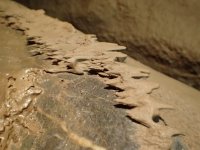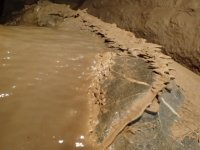You are using an out of date browser. It may not display this or other websites correctly.
You should upgrade or use an alternative browser.
You should upgrade or use an alternative browser.
Strange mud formations
- Thread starter PeteHall
- Start date
caving_fox
Active member
Is that on a ridge? Water lapping in on both sides, but not quite overflowing?
PeteHall
Moderator
caving_fox said:Is that on a ridge? Water lapping in on both sides, but not quite overflowing?
Not really, here's another shot from slightly further back:
Attachments
Pitlamp
Well-known member
They look like something I've seen in Peak Cavern's Far Sump Extension.
If so, are they formed by unidirectional flow eroding the mud deposit? Clay particles get stuck to each other by molecular forces and don't then separate easily. It can lead to unusually shaped residues when they're partially eroded by moving water, when some parts of the sediment are better bonded than others.
If so, are they formed by unidirectional flow eroding the mud deposit? Clay particles get stuck to each other by molecular forces and don't then separate easily. It can lead to unusually shaped residues when they're partially eroded by moving water, when some parts of the sediment are better bonded than others.
PeteHall
Moderator
Pitlamp said:They look like something I've seen in Peak Cavern's Far Sump Extension.
If so, are they formed by unidirectional flow eroding the mud deposit? Clay particles get stuck to each other by molecular forces and don't then separate easily. It can lead to unusually shaped residues when they're partially eroded by moving water, when some parts of the sediment are better bonded than others.
I'm not going to argue with that explanation, as I'm far to ignorant, but I can't quite visualize how it happens.
Are you suggesting that the flow would have been travelling past the mud, with the mud at the water's surface, or underwater? I imagine it would have to be a very gentle and consistent flow to make such a delicate formation.
pwhole
Well-known member
Looks to me a bit like those 'Penny Falls' you get at the fairground - as in, occasionally some sediment falls off the front lip, and a bit more gets piled up at the back. The protruding lips are strong enough to hold when the water level is at or above their level, but if it drops, the next flow will have enough force for some more new bits at the front to drop off, ad infinitum.





